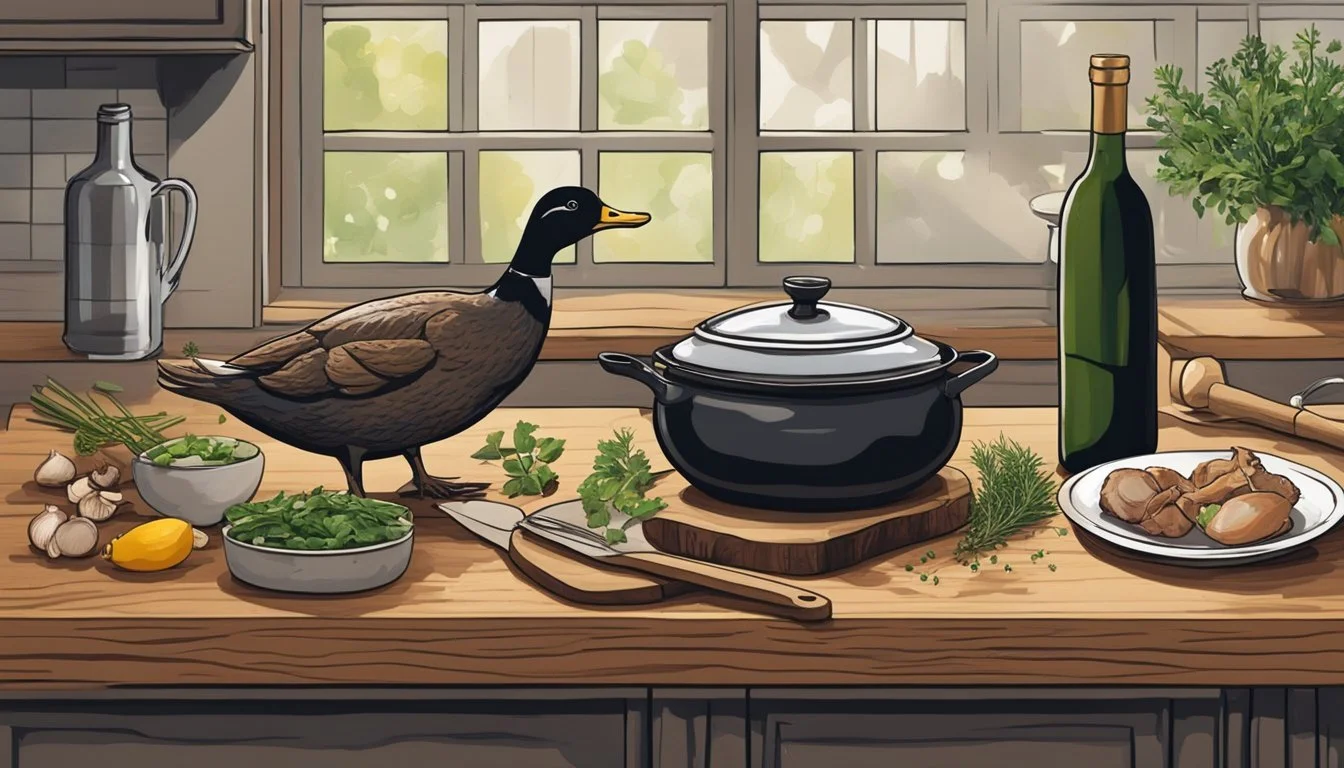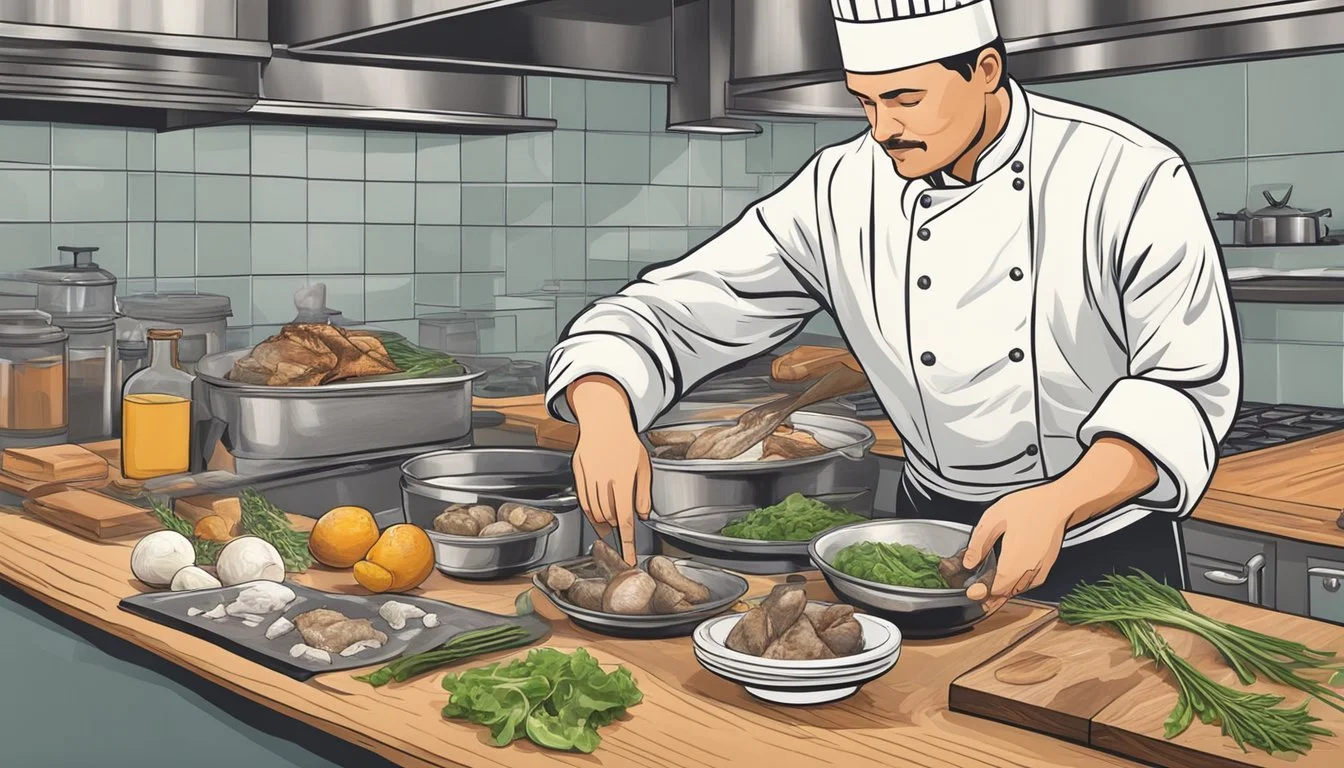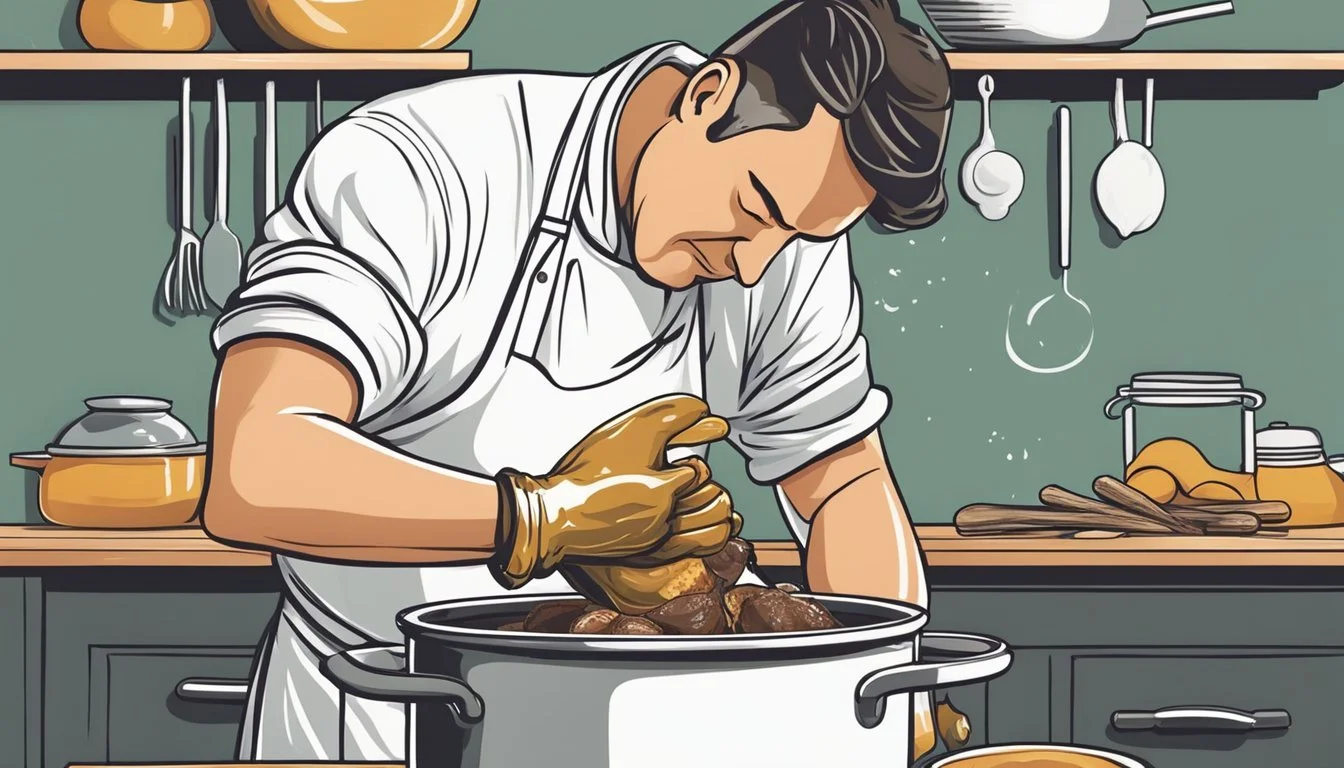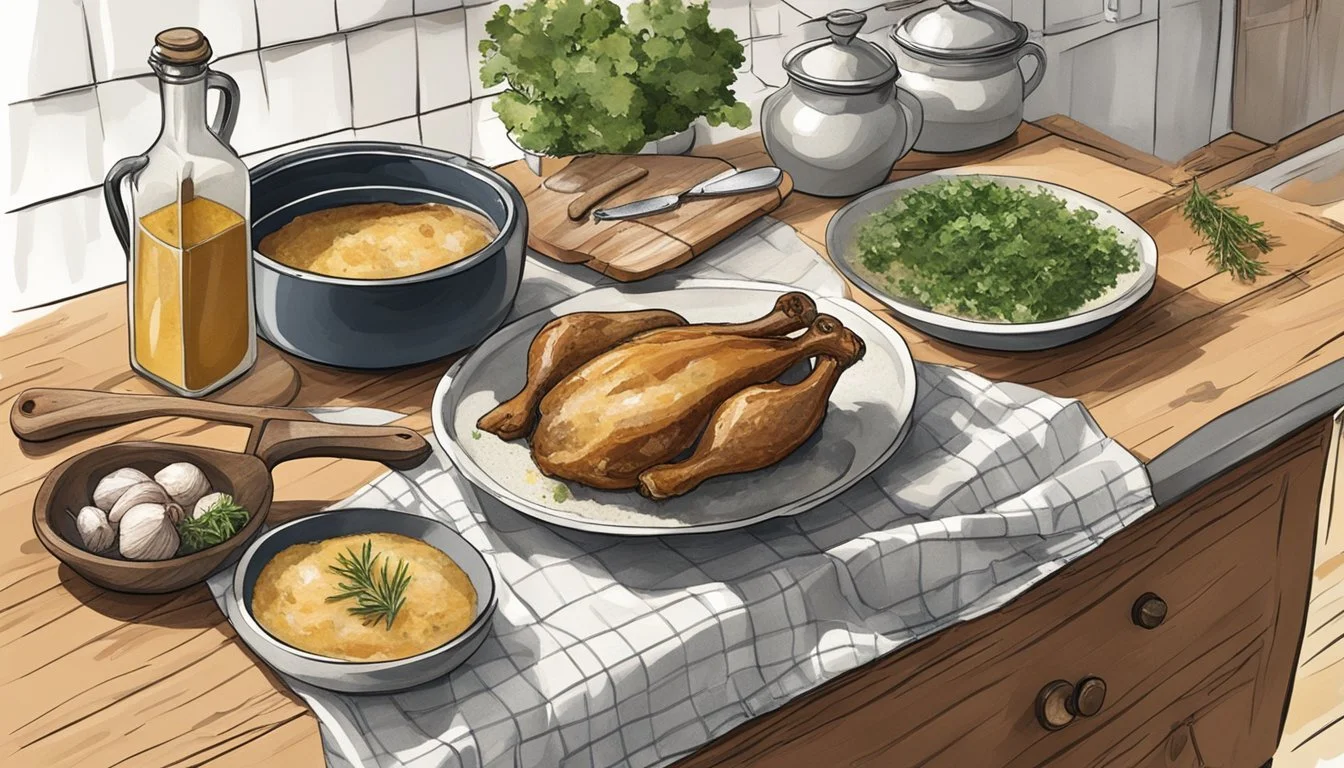Homemade Duck Confit
A Gourmet Way to Use Up Leftover Duck Legs
Duck confit (What wine goes well with duck confit?) is a classic French dish known for its rich flavor and tender texture. Traditionally made by slow-cooking duck legs in their own fat, it is a sumptuous way to transform leftover duck into an elegant meal. The process begins by curing the duck legs in a mixture of salt, herbs, and spices, which serves to both season the meat and draw out moisture. After the curing process, which can last from 12 to 24 hours, the duck is cooked at a low temperature in an oven until the meat is fall-off-the-bone tender.
Preparing duck confit at home is a rewarding endeavor that doesn't require expert cooking skills but does demand patience. Once cured, the legs are submerged in fat and cooked slowly, a technique ensuring the preservation of the duck as well as enhancing its flavor. The result is a succulent dish that can be served with a variety of sides or added to other recipes. Additionally, if properly stored submerged in its cooking fat, duck confit can be kept for several weeks, allowing the flavors to mature further.
The dish's final step often involves crisping the skin to achieve the desired contrast in textures. This can be accomplished by increasing the oven's temperature or by pan-searing the duck legs skin-side-down until the skin is golden and crisp. Duck confit's versatility in serving and its potential to elevate simple ingredients to a gourmet level make it a worthy recipe for those looking to explore the depth of French cuisine at home.
The Essence of Duck Confit
Duck confit stands as a luxurious method of preserving duck legs, deeply rooted in French culinary tradition and characterized by a slow-cooking process in its own fat.
Historical Background of Duck Confit
Confit, derived from the French word confire which means "to preserve," hails from the gastronomic heartlands of Gascony, France. It emerged out of necessity, serving as a means to save meats for the harsh winter months. The method was favored for its dual utility: it tenderized the meat while extending its shelf life thanks to the preserving qualities of fat. French cuisine integrated this technique, celebrating it for its rich flavor profile and the succulent texture it imparted to duck legs, a common fowl in the region.
Understanding the Process
To create duck confit, chefs begin with an essential step known as curing.
Curing: Involves coating the duck legs in a mixture of salt, herbs, and sometimes spices, allowing it to cure, typically for 24 to 36 hours. This process intensifies the flavors and starts the preservation.
Slow-Cooking: Post-curing, the duck legs are slow-cooked at a low temperature (around 250°F to 325°F) submerged entirely in duck fat. This can take several hours, during which the meat becomes exceptionally tender.
Preservation: Once cooked, the duck legs can be stored in their own fat, often in a cool place, which can effectively preserve them for weeks to months, embodying the essence of the traditional French preparation.
Selecting Ingredients
When creating homemade duck confit, the quality of each ingredient plays a pivotal role in the depth of flavor and texture in the final dish. Selecting the best-quality ingredients ensures a delicious and authentic confit.
Choosing Quality Duck Legs
One must seek duck legs that are plump and have a good amount of meat on them. Freshness is key, so they should have a firm texture, a pleasant smell, and skin that is intact without any bruises. It is often recommended to use legs from the Pekin or Muscovy breeds for their rich taste and suitable fat content.
Types of Duck Fat for Confit
The use of high-quality duck fat is essential for confit, as it serves as the medium in which the duck legs are slow-cooked. Options include:
Rendered Duck Fat: A purified form, commonly available and ideal for confit.
Fresh Duck Fat: Can be rendered from the trimmings of the duck itself if available.
Both types of fat should be free of impurities and have a subtly sweet, rich aroma.
Fresh Herbs and Spices
Accentuating the duck legs with the right herbs and spices elevates the dish's complexity.
Garlic: Use cloves that are firm, unblemished, and aromatic.
Thyme, Sage, and Rosemary: Fresh herbs are preferable over dried for their vibrant flavors.
Shallots: They should be firm to the touch, without any sprouts or soft spots.
Bay Leaves: Fresh bay leaves impart a subtle depth, but dry leaves are also acceptable.
Black Pepper and Kosher Salt: Freshly ground pepper and kosher salt are essentials for seasoning.
Incorporating these carefully chosen ingredients will lay the foundation for a flavorful duck confit.
Preparation Techniques
The preparation of duck confit involves two critical steps: curing the duck legs to enhance flavor and tenderness, and preparing a bouquet of aromatics to infuse the confit with classic fragrance. These steps are instrumental in achieving the dish's signature taste.
Curing the Duck Legs
The curing process begins by generously coating the duck legs with coarse salt. Ingredients such as cloves, fresh thyme, and bay leaves are often added to the salt mixture to impart additional depth of flavor. It's essential to ensure that the legs are evenly covered on all sides. The duck should then be refrigerated to cure, ranging typically from 12 to 24 hours. During this time, the salt not only seasons the meat but also works to draw out moisture, which is key to the confit's texture.
Assembling the Aromatics
Distinctive aromatics are crucial to duck confit’s allure, each bringing its unique flavor profile to the dish. A standard set of aromatics might include:
A few cloves
Sprigs of fresh thyme
One or two bay leaves
These are usually laid in the bottom of the cooking vessel before the cured duck legs are placed on top. Aromatic herbs and spices are a bridge between the rich duck and the subtle layers of savory notes that define a well-crafted duck confit.
Cooking Methodology
Homemade duck confit requires patience and precision in the cooking process. This section outlines the essential techniques for slow cooking duck legs at a low temperature, ensuring a tender and flavorful result.
Slow-Cooking Fundamentals
To prepare duck confit, one begins by curing the duck legs with salt and a blend of herbs and spices. The process typically involves coating the duck thoroughly and allowing it to cure for 12 to 24 hours. After curing, the legs are slow-cooked submerged in their own fat. This method of cooking, known as confit, is achieved over a low, consistent heat which breaks down the tough muscle fibers without drying out the meat.
Key steps in slow cooking duck confit:
Cure duck legs with salt and herbs for 12-24 hours.
Rinse the cured duck and pat dry.
Place duck legs in a single layer in a cooking vessel.
Submerge the legs in melted duck fat.
Managing Cooking Temperature
Achieving the correct cooking temperature is crucial for a successful duck confit. The duck legs should be cooked at a low and steady temperature, typically between 225°F to 250°F (107°C to 120°C). Cooking time varies but a time frame of 3 to 4 hours is often sufficient for the meat to become tender and fully infused with the flavors of the fat and seasoning.
Important temperature considerations:
Preheat the oven to a low temperature to ensure gentle cooking.
Maintain a steady temperature, checking occasionally to avoid overheating.
Use a thermometer to monitor the temperature of the oven if it does not hold consistent temperatures well.
Finishing Touches
In the final stages of preparing Homemade Duck Confit, achieving crispy skin and mastering searing techniques are crucial to enhancing the dish's texture and flavor.
Achieving Crispy Skin
For the crispy skin, an essential characteristic of Duck Confit, the chef preheats the oven to 400°F (205°C). They place the cured duck legs skin-side up on a wire rack over a baking sheet or in an oven-safe skillet. The chef should monitor the duck legs carefully, letting them roast until the skin is evenly browned and crisp, which may take approximately 10 to 15 minutes.
Searing Techniques
Searing is an alternative method that requires an oven-safe skillet heated over medium-high heat. The chef adds the duck legs skin-side down to render out any remaining fat and achieve a golden-brown crust. Attention to heat control is vital; the duck should sear for about 3 to 4 minutes until the skin is irresistibly crispy.
The chef uses tongs to handle the duck carefully to prevent tearing the skin which can detract from the final presentation. They ensure that each leg is seared uniformly for the best texture and taste.
Serving and Presentation
The art of serving and presenting Duck Confit elevates this already elegant dish. Carefully chosen side dishes can complement its rich flavors, while thoughtful plating will showcase the confit's perfect texture and color.
Complementary Side Dishes
Duck Confit pairs wonderfully with Roasted Potatoes. Their crispy exterior and fluffy interior can absorb the duck's flavorful fat, making a harmonious combination. For a lighter option, present it with a Green Salad dressed lightly in a tangy Vinaigrette to cut through the dish's richness.
Roasted Potatoes:
Crispy and golden-brown
Sprinkle with coarse salt and rosemary
Green Salad with Vinaigrette:
Fresh, crisp greens like arugula or mixed lettuces
Vinaigrette: mix of olive oil, vinegar, Dijon mustard, salt, and pepper
Plating Duck Confit
When plating Duck Confit, start with the duck leg as the star. Position the confit leg at the center of the plate with the skin side up to highlight its enticing golden-brown hue. Arrange the Roasted Potatoes and Green Salad around the duck, ensuring each component is visible and the plate is not overcrowded. The splash of color from the salad will contrast beautifully with the rich tones of the duck and potatoes, creating an appetizing visual balance.
Storage and Reheating Tips
To maintain the quality of homemade duck confit, one must adhere to appropriate storage and reheating methods. This ensures the preservation of flavor and texture.
Proper Storage Methods
Refrigeration is critical for storing duck confit. The duck should be cooled to room temperature and then placed in a container. It is important to submerge the legs completely in the excess fat before sealing the container. This method can preserve the duck confit for up to several weeks. Here's a step-by-step process:
Allow the duck to cool to room temperature.
Transfer the duck into a storage container.
Cover fully with excess duck fat.
Seal the container and refrigerate.
Best Practices for Reheating
Reheating Duck Confit requires gentle warming to retain its tender texture and crisp skin. An oven or a microwave can be used for this purpose.
Oven Method:
Preheat the oven to 400 degrees F.
Place the duck skin-side up on a tray.
Heat for 30-40 minutes. Turn it halfway through to ensure even warming.
Once golden brown and warmed through, allow it to rest for a few minutes.
Microwave Method:
Place the duck in a microwave-safe bowl.
Cover with plastic wrap and heat on high for five minutes.
Flip halfway through to ensure even heating.
Remove the duck from the microwave, discard the plastic, and serve.
Each reheating technique should ensure that the duck is served with a rejuvenated taste and texture without compromising its quality.
Alternative Uses and Substitutions
Homemade duck confit is a versatile dish that can be adapted using various substitutes and applied in creative ways. This section explores practical alternatives for rendered duck fat and innovative applications for leftover duck confit, ensuring no ingredient goes to waste.
Substitutes for Duck Fat
Store-bought duck fat: It's readily available and can be a direct substitution for homemade rendered duck fat.
Chicken fat (schmaltz): A viable alternative if duck fat is not accessible.
Olive oil: A healthier option, olive oil can be used, though it may slightly alter the flavor profile.
He/she/they may store duck confit or its substitutes in an airtight container in the refrigerator for up to 3 days or freeze for up to 3 months to ensure freshness and longevity.
Creative Uses for Leftovers
Salads: Shred leftover duck confit and add it to green salads for a protein boost.
Pasta dishes: Incorporate into pasta sauces for a rich, meaty component.
Sandwiches and wraps: Use shredded confit as a filling, paired with complementary condiments and vegetables.
One can use leftovers to make a delicious base for fried chicken by coating the chicken with seasoned flour and frying it in the same fat used for the confit. This approach not only utilizes the rich duck fat but also adds a gourmet twist to the classic fried chicken.
Tips and Techniques for Perfection
To achieve the perfect homemade duck confit, one must pay attention to detail and follow a meticulous process. This section offers deep insights into the potential pitfalls and pro-level maneuvers that can elevate the dish from good to exquisite.
Mistakes to Avoid
Excess Salt: Over-salting can cause the duck to become unpalatably salty. It's essential to use just enough salt to cure the legs properly. One should rinse off any excess salt before the cooking process begins.
Incorrect Temperature: Cooking duck confit at too high a temperature may lead to tough meat. Maintaining a low and steady temperature in the oven—ideally between 225°F to 325°F—ensures that the duck legs cook evenly and remain tender.
Overcrowding the Pan: Duck legs should be placed in a nonstick skillet or cooking vessel in a single layer to allow for even heat distribution. Overcrowding can lead to uneven cooking and less than perfect texture.
Improper Storage: If not consumed immediately, store the duck confit covered in its cooking fat. This seals out air and extends the shelf life, keeping it moist and flavorful.
Expert Tricks
Sharp Knife: Utilize a sharp knife to score the duck skin before cooking. This technique helps render out excess fat and achieve a crispy exterior.
Layered Flavors: Add depth to the dish by incorporating herbs and spices such as thyme, bay leaf, garlic, and black pepper during the curing stage. These should be massaged into the duck legs thoroughly.
Alternate Cooking Vessels: While a traditional oven works well for confit, a slow cooker or crockpot can be an effective alternative. They maintain consistent low temperatures ideal for the slow cooking process confit requires.
Finish with a Sear: After the slow cooking process, a quick sear in a hot nonstick skillet can provide an appealing golden-brown finish and textural contrast to the succulent duck.
Where to Buy Ingredients
When preparing homemade duck confit, sourcing high-quality ingredients is paramount. The ideal shopping list includes fresh duck legs, duck fat, thyme, and various other seasonings. The quest for these components can be approached by understanding the difference between fresh and packaged options, and by identifying the best places to purchase them.
Choosing Fresh Over Packaged
Customers should prioritize fresh duck legs over packaged ones to ensure the richest flavor. Fresh duck legs can often be found at the meat section of local supermarkets or at specialized butcher shops. In contrast, packaged duck legs might be available, but they could be frozen or contain preservatives that potentially affect the taste. For herbs like dried thyme, fresh is not a necessity, but quality matters. One should look for well-sealed and well-reviewed brands that promise freshness, even in dried form.
Tip: Ask the butcher or the supermarket staff if they can order fresh duck legs if not readily available.
Online and Local Sources
Duck legs and duck fat may not always be on the shelf at local stores, but online retailers can be a reliable source. Here is a basic guide:
Duck Legs:
Supermarkets: Check availability and inquire about delivery.
Online Gourmet Food Stores: Search for providers that specialize in poultry.
Duck Fat:
Supermarket Chains: Look in the oils section or near international foods.
Online: Consider reputable retailers who guarantee product quality with customer reviews.
Tip: Online purchases may cost more due to shipping, yet offer a wider selection.
For dried thyme and other seasonings, consumers are likely to find a variety at:
Local supermarkets in the spice aisle.
Online through spice specialists or marketplaces.
In securing these ingredients, shoppers contribute significantly to the overall quality and authenticity of their duck confit.








